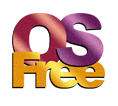Table of Contents
![]()
![]() This is part of Family API which allow to create dual-os version of program runs under OS/2 and DOS
This is part of Family API which allow to create dual-os version of program runs under OS/2 and DOS
Note: This is legacy API call. It is recommended to use 32-bit equivalent
DosQCurDisk
This call determines the current default drive for the requesting process.
Syntax
DosQCurDisk (DriveNumber, LogicalDriveMap)
Parameters
- DriveNumber (PUSHORT) - output : Address of the number of the default drive, for example:
Value Definition' 1 A 2 B . .
- LogicalDriveMap (PULONG) - output : Address of the bit map (stored in the low-order portion of the 32-bit, doubleword area) where the system returns the mapping of the logical drives. Logical Drives A to Z have a one-to-one mapping with the bit positions 0 to 25 of the map; for example, bit 0 is drive A, bit 1 is drive B, and so forth. The settings of these bits indicate which drives exist:
Value Definition 0 The logical drive does not exist. 1 The logical drive exists.
Return Code
Bindings
C Binding
#define INCL_DOSFILEMGR USHORT rc = DosQCurDisk(DriveNumber, LogicalDriveMap); PUSHORT DriveNumber; /* Default drive number (returned) */ PULONG LogicalDriveMap; /* Drive map area (returned) */ USHORT rc; /* return code */
MASM Binding
EXTRN DosQCurDisk:FAR INCL_DOSFILEMGR EQU 1 PUSH@ WORD DriveNumber ;Default drive number (returned) PUSH@ DWORD LogicalDriveMap ;Drive map area (returned) CALL DosQCurDisk
Returns WORD
Note
Text based on http://www.edm2.com/index.php/DosQCurDisk




